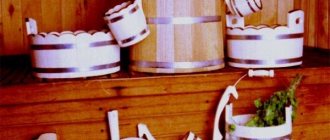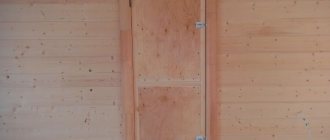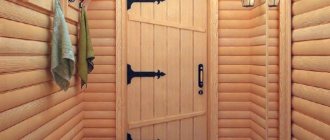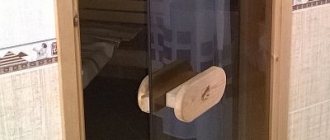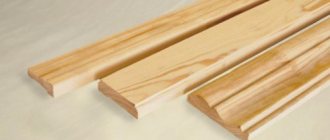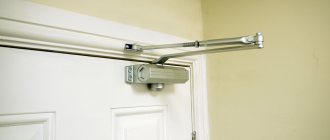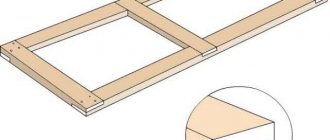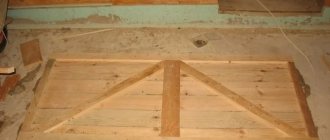How important is a good wooden handle for a bathhouse? The answer to the question is obvious. Try removing it from the doors and try to take a steam bath at least once without this extremely necessary element of door hardware. In addition, a bath handle for a good owner has always been and remains one of the ways to decorate the entrance, complement the door leaf, and make the facade brighter and more expressive.
Requirements for the design of a bath handle
Like all important things, it is impossible to make a handle for a bath door at random, without knowing how the material and design will behave.
It is always hot in the steam room of the bathhouse, and the entrance door to the steam room is usually built massive, with a tight fit in the frame. Therefore, the convenience and safety of using the steam room depends on how correctly the handle for the bath is made with your own hands. Bathhouse door handles must meet the following requirements:
- The body must be quite massive and durable. In the event of smoke in a steam room or bathhouse, it is much easier to see a bulky arc than a small ball of wood;
- The material should not absorb moisture, have low thermal conductivity and not emit volatile substances when heated.
Bathroom door handles are made of wood, no plastic, rubber, much less metal, even if the hand grip area is insulated with a fabric, leather or felt cover. It is not difficult to wash the body of the handle, but it is very easy to get a burn if you accidentally grip a metal part incorrectly in a hot steam room.
Contrary to popular belief, wooden door handles for bathhouses are quite durable and can serve their owners for one and a half to two decades.
GLASS UNIT
When ordering any window, it is important to choose the right glass unit, and for a bathhouse this is even more important.
Firstly, the double-glazed window must be warm - then it will save a lot of energy when heating the steam room.
Secondly, the double-glazed window must be heat-resistant, because ordinary glass is not designed to operate at temperatures below one hundred degrees.
Thirdly, the double-glazed windows should not be afraid of low temperatures - not all baths are heated in winter, and ordinary double-glazed windows are also not designed for this.
Therefore, we suggest using a special double-glazed window: double-chamber with energy saving and argon, and tempered inner glass.
Features of wood door handles
Since ancient times, door fittings have been made from wood. Later, they were given a worthy fight by steel products and elements made from modern materials. Even today, wood models are widely popular due to their advantages:
- Properly sanded and processed wood is soft to the touch. A wood handle is not as cool as a metal or plastic handle.
- Accessories made from wood are irreplaceable when arranging baths and saunas. Wooden elements do not heat up to enormous temperatures like steel ones, and the possibility of getting a burn when handling the handle is reduced to zero.
- Easy to make wooden door handles with your own hands. Wood is easy to process, and working with it does not require expensive equipment. Using bars, slats or logs, it will be possible to create a structure of any shape.
- Affordable price.
Despite the significant advantages, wood products also have some disadvantages:
- The strength properties of wood are inferior to steel elements. This fact must be taken into account when constructing a structure that is subject to significant loads. In this case, it is better to give preference to hard wood or metal.
- With prolonged contact with steel surfaces, the wood is destroyed. Based on this, door handles for doors must be selected in accordance with the material of the door leaf.
- In order for a wooden handle to serve for a long time, it must be carefully treated: sanded and impregnated with protective compounds.
Insulating the front door
With our harsh winters, insulating the entrance door to the bathhouse becomes a very important issue.
In most of our country, winters are very harsh, and bathhouses are usually built separately, unlike Finnish saunas, which can also be located inside a residential building.
We will tell you how to make sure that in winter the desired heat from the bathhouse does not escape into the street, and the frosty air does not penetrate into the bathhouse and does not chill the feet of those who are washing. To do this, you need to mount a certain structure with your own hands.
Insulation instructions:
- we take bars 20 mm thick and nail them along the entire contour of the existing door leaf from the outside so that the bars protrude beyond the edge of the door by about 15 mm;
- We nail insulation around the perimeter of the resulting frame, preferably felt folded in half; the insulation should protrude with its folded side 15 mm beyond the edge of the block;
- You can also install any insulation into the void of the frame that is formed between the bars;
- We stuff a sheet of fiberboard or plywood onto the frame directly to the size of the frame itself, so that the rolled felt peeks out around the entire perimeter of the door from under the plywood.
When closing the front door, the leaf fits precisely into the door block, and the insulation, bending outward, reliably cuts off the possibility of frosty air entering the interior.
What to expect from wooden crafts
Before getting to work, let’s evaluate the properties of homemade fittings. Advantages of a wooden handle:
- the design and shape of the product can be very different;
- natural material with low thermal conductivity causes pleasant tactile sensations;
- for the same reason, wood does not burn your hand on the bathhouse door;
- you don’t have to spend money on accessories;
- “metallists” will not take the pen for scrap;
- If it fails, you can make an even better one.
Disadvantages, as always, are also present:
- the service life of wooden crafts, especially outdoors, is limited;
- You will have to work hard to create a beautiful, comfortable and high-quality product.
Important points
When making a product from a board, consider several important points:
- The bark must be removed from the material, otherwise the handle will not last long.
- All edges of the product are carefully sanded, as are the canvas and the box. At first, you can use a power tool, but you will have to manually adjust the evenness.
Simple products
Simple wooden handles
- All wooden parts are treated with special compounds. This will protect them from moisture (especially if the handle is for the bathhouse door), microorganisms (fungi, mold), and fire.
- To give the handle a tint, use a wood stain of a suitable tone.
- Finishing is varnishing in several layers. At the same time, make sure that there are no drips left on the product.
Handle on the bath door
Options for door handles for baths
Most owners of bathhouse apartments prefer to make wooden door handles for the bathhouse with their own hands. On the one hand, creativity and the opportunity to make an unusual door decoration design. On the other hand, it is better to do the most important things yourself.
There are an incredible variety of forms and options for constructing wooden door handles for a bathhouse. Starting from an intricate design in the shape of a ship's wheel, ending with a standard ball used for ordinary inter-apartment door blocks.
The most popular models:
- Handles in the shape of an arc nailed to the door leaf. The body can be carved from solid wood, a branch or a tree root. The outer surface is traditionally decorated with wood carvings;
- Straight, most often industrially made, without any decorative elements. Such models are used primarily for glass bath doors;
- Twin structures. In one product, a wooden handle is combined with a locking device or deadbolt;
- Compact furniture models made of wood, usually spherical, “umbrella” or “mushroom”.
There is a special category - carved wood compositions. Such products are made by professional carvers according to the individual order of the bathhouse owner. The handle for the bathhouse is ordered specifically to complement the design of the wooden entrance doors and the facade of the bathhouse.
According to the form and principle of operation
There are the following main types of door handles:
- stationary (brackets);
- fall ones with a push mechanism;
- halyard with a rotating mechanism (nobs).
Stationary handles are installed on the door using several screws or tension screws. They serve solely to pull the door when opening and push when closing.
Stationary handles do not interact in any way with either the latches or the lock.
According to their shape, this fittings are divided into several subtypes - there are U-shaped, spherical and round stationary handles.
Handles with a push mechanism are equipped with a latch, embedded in the door. The principle of their operation is as follows: when you press the handle, a spring is activated, retracting the latch into the “bowels” of the leaf - thus, the door opens. If the handle is not mechanically affected, the latch is constantly in the extended position.
This system is extremely convenient if there is a constant need for tightly closed doors in the house.
Worth knowing! All classic mortise locks are equipped with just such handles - with a push mechanism.
When replacing old lever handles with new ones, do not forget about the latches. After all, by purchasing fittings with latches that are different from the ones you already have, you are exposing yourself to unnecessary headaches - you will have to additionally cut and, possibly, patch the fabrics.
Installing door handles with your own hands will take you a matter of minutes if you select new elements with dimensions similar to the old ones.
Handles with a rotary mechanism (knobs) are spherical in shape. Often, a keyhole is integrated into their center. At the same time, they can be opened with a key only on one side; on the other side there is a locking button or latch. Such fittings are an excellent choice for internal doors, especially to the bathroom and toilet.
How to choose?
Door handles must necessarily be combined not only with the door itself, but also with the general character of the interior. When purchasing, it would be a good idea to evaluate the fittings by touch; evaluate how it lies in your hand and whether it causes any unpleasant sensations.
Also consider the degree of load on the handle. Agree, on a powerful, heavy door, the frail fittings will quickly become unusable - they simply will not withstand the efforts that you will have to put into manipulating the door.
Door handles differ in price just as much as in all other parameters. Depending on the shape and material, their cost can range from several hundred rubles to... an amount exceeding the cost of the door itself.
Making a wooden door for a steam room
Let's assume that our bathhouse is a log house. This is the most common and optimal design.
Choosing a door size
The door will be exposed to extreme heat and humidity
It is very important that steam not only does not escape when the door is closed, but also that it escapes to a minimum when people enter and exit. Therefore, the door to the steam room is traditionally made low
Its height depends on the height of the finished ceiling of the steam room itself, and it, in turn, depends on the height and number of “floors” - shelves. But the ceiling in the bathhouse is never very high - usually it is at the level of 220–230 centimeters.
We calculate: 230–60 = 170 centimeters, subtract the “margin” of 10 centimeters, result: the optimal door height is 160 centimeters.
Another condition is a high threshold. It prevents the coldest air, which is usually located near the floor, from entering the steam room when people enter and exit and protects against drafts when the door is closed. There is another funny advantage: when we raise our leg, we involuntarily remember the low ceiling and avoid unnecessary head impacts.
The width of the door depends not only on the above factors, but also on your convenience. Usually it is not very wide, but not too narrow so as not to squeeze through. Let's take the width to be 70 centimeters.
The drawing indicates the dimensions of the door and door frame
The door should not be greatly deformed, swell or dry out due to changes in temperature and humidity. Therefore, it must be made of dense, high-quality wood.
The decoration of the bathhouse is usually finished with wood. Wooden bath products not only decorate the interior, but also have a number of practical advantages and also provide health benefits to visitors.
We will tell you about the features of such products, and also show you how to make simple devices with your own hands.
The procedure for its manufacture is generally the same as for its wooden counterpart for the entrance. But there are a number of points that must be taken into account.
- The canvas should cover the opening as tightly as possible so that steam does not escape from the room.
- The threshold is low; maximum 50 mm.
- Opening - outwards. Otherwise, the hinges (even the best quality) of the bath door will quickly rust.
- If the bathhouse is heated “in white”, then one door is enough; “in black” – necessarily two.
Let's make a simple handle with our own hands
Regardless of whether the wooden handle will be custom-made by a carver, or all the details, from the design to the installation on the bathhouse doors, will have to be done with your own hands, first of all, you need to choose the right type of wood and the shape of the workpiece.
Cutting a wooden handle from linden
The ideal option for a wooden handle, suitable for any bathhouse door, can be considered a simple arched model with a reach of 35-40 mm and a length of 25-30 cm. If you do not have much experience in carpentry, then it is best to start by making a wooden handle from linden wood.
Solid wood sauna front door product
After a round blank has been cut out of solid acacia, oak or walnut, it is necessary to mark the future base of the handle. The wooden base made of oak is much more difficult to cut, but at the same time it becomes possible to use a more complex product design.
The easiest way to make a wooden handle for the entrance door of a bathhouse is from two parts - the base and the holder itself. To achieve a harmonious combination, we cut out the base on a router in the form of a shaped platform with support spots for installing a holder. The dimensions of the supporting part of the curly handle should not be too large; a platform of 20x10 cm is sufficient.
Using a chamfer cutter we go along the contour of the wooden base, we get a nice fillet.
After milling the contour, the surface of the workpiece is cleaned with emery cloth.
To make a wooden holder, you can use a walnut or ash branch. The shape and size can be selected to match the design style of the bathhouse entrance door. The surface is cleared of bark and sanded.
The finished parts are connected with oak wooden pins; you can use metal fasteners, but then you will have to cut a steel bushing with an internal thread into the holder. As a result, you will need to make holes in the wooden case, or make the holder too massive.
After two wooden parts are connected into one structure, the holder and base are coated with varnish or epoxy compound and, after curing, they are attached to the entrance door of the bathhouse.
Since the entrance to the bathhouse is not much different from the front door of an ordinary house, the design of the wooden handle can be supplemented with decorative elements made of metal and plastic.
Varieties
Each bathhouse has several different rooms:
- dressing room;
- locker room;
- washing room;
- steam room
There may be additional rooms, and each requires its own door design.
At a minimum, two such structures must be installed in the bathhouse:
- external entrance door for the bathhouse;
- internal door to the steam room.
Based on the material of manufacture, there are three options for choosing for the manufacture of door structures for bathhouses or saunas.
Wooden
Original carved door for a bathhouse made of linden.
The wooden door leaf is made from tongue-and-groove boards and then covered with clapboard (see also the article “Do-it-yourself wooden doors to a bathhouse - manufacturing technology”). The material for such structures must meet the stringent requirements for this product. It happens that doors are made with artistic carvings, but in this case their price increases significantly.
Let's look at the materials that can be used:
Glass
The advantage of tempered glass doors is their ability to withstand high temperatures.
Recently, door structures for baths and saunas made of special tempered glass have become especially popular. They are especially often installed in saunas and Turkish baths.
The material for such structures is durable 8mm tempered glass.
This glass has all the necessary qualities, it:
- water-repellent;
- heat-resistant, can withstand temperatures up to 300 °C;
- safe;
- inexpensive;
- easy to maintain, easy to wash and clean;
Combined
The photo shows a variant of the combined design for the entrance to the sauna.
The combined version contains wood and glass, which is very convenient and beautiful. Usually, a window insert of different sizes is made into the frame, which is made of wood of suitable species. It can be the size of almost the entire canvas or very small, as you like.
Lightweight version of a wooden handle for a bath
A homemade door handle will amaze the guests of the bathhouse and will become the pride of the owners of the steam room. Constructing a lightweight model will not be difficult. Let's look at an example of creating a pen with a length of 20 6 cm and a height of 10 cm. To work, you will need a board with dimensions of 26 * 10 * 5 cm, a light pencil and a jigsaw.
Door handle in Russian folk style
An example of a carved handle will harmoniously fit into an interior designed in a traditional folk style. The handle will perfectly complement an antique-style door. The design of the model includes 6 parts:
First you need to prepare each part separately, fit them together and polish them. Production order:
Determine the purpose and choose the method of making a homemade pen
Most often, a handle is used to open or close a door. In this case, you can make a latch, hook or bolt from wood that will fix or lock the door.
The products shown in the photo were made on a lathe. The small button-style handle consists of only one piece and is better suited for furniture.
To open a heavy door, it is better to make a full-fledged handle from three parts. I would choose the option with a crossbar that is inserted into the supports (above right), which provides the greatest strength to the craft.
Carved handles are good in their own way. There are an indescribable variety of options for such products. To make something like this, you need to have a set of cutters and artistic taste. At the same time, it is quite possible to process simple handles with a knife.
I advise you to take a close look at overhead handles: they can be simple, reliable and even sophisticated at the same time. Such fittings can be cut with an ordinary hacksaw or jigsaw.
If a three-piece handle is secured with self-tapping screws through the main element through the stands, the product will be very durable. The height of the stands should be ensured to provide sufficient clearance for fingers.
Flat handles are the most popular, and they are made from boards. I recommend the option located in the photo below right: it is the most reliable, since the handle opening is located below the screw heads. In this case, the craft will not break along the fibers.
To make fittings, you need to apply drawings of the parts on the plane of the board, and then cut the workpiece with a jigsaw. Of course, sanding will be required.
Holes for fastening should be provided. They are drilled out at the top with a large diameter to hide the screw heads.
Accessories made from natural materials can be decorated with carving elements, applied with drawings or icons using a burner, or treated with a blowtorch. A more complex version uses linings cut with a jigsaw. To attach a handle from a branch, you need to prepare several holes for self-tapping screws so that the fittings do not wobble and are held securely.
Doors to the sauna: fittings
Learn more about hinges and handles. Of course, hinges differ slightly from each other depending on the design and material for which they are made. The handles also have differences.
Hinges for sauna doors
Sauna hinges must be made of stainless materials. This applies to any type of canvas
In addition, when choosing hinges, you should pay attention to the maximum weight for which they are designed
For glass
There are two types of glass hinges - clamping and drilled. The former do not require violating the integrity of the canvas. The second holes should already be ready, because you cannot drill through tempered glass. However, upon purchase you receive a fully equipped door, so the choice has already been made.
However, you should know that the material for the hinges can be:
- aluminum;
- stainless steel;
- brass;
- bronze.
The surface of the hinges is usually anodized with chrome or nickel. On top of the metal parts there is also (often) a plastic plug installed, which is also chrome-plated or nickel-plated on the surface.
Hinges for wood
On sale you will find the following types of hinges:
- mounted;
- screw-in;
- mortise
Invoices
Hinges for sauna doors: overhead.
Overhead loops are not disguised; on the contrary, they are often used as a decorative element. They are located on the outside of the door, attached to the frame and leaf on the side where the door will open. See picture.
Overhead hinges are most often used in bath doors. But if the sauna is in an apartment, you are free to use any options.
Screw-in
Another name is pin. Suitable for doors in which not only the frame, but also the door leaf has a false quarter.
KEEP IN MIND! They cannot be installed on a regular door - see diagram below.
They are distinguished by minimalism - instead of a mortise hinge bar, into which a bunch of screws are screwed, the screw-in hinge has only a couple of pins, one for the box, the other for the canvas.
Photo of screw-in (pin) door hinges
The main advantage of this type of hinge is simple adjustment using a hex key: you can tighten the position of the door leaf in the vertical and horizontal direction, as well as adjust the force of pressing the door against the frame.
ATTENTION! The greater the mass of the door leaf, the more pins there are in the hinge design. There may be 2-3-4 of them
The usual material for making this type of hinge is steel. But it can be aluminum or non-ferrous metal.
Mortise
They are also called card games. They differ in that their strips are hidden in the side end of the door and the adjacent section of the frame. These are the most common hinges that are often found in interior doors. However, the front door can also be supported by mortise ones. They are also applicable in the sauna.
Butterfly (pictured right) is a type of card loop that is twice as thin as a regular loop due to its ingenious design. Its advantage is that you can make a recess only in the frame, without making it in the door, or vice versa, only in the door, leaving the door jamb untouched.
For glass
Since you are purchasing a ready-made door, you should take care of the shape of the handles when choosing a model. Manufacturers offer either handles in the form of a bracket (vertical or horizontal) or knobs. Both can be made of glass or wood, but in a sauna the second is preferable, because you can get burned on glass.
For wood
In principle, the shape of handles intended for glass may be no different from handles for wooden sauna doors, but they are designed for a certain thickness of the leaf, which for glass is usually 8 mm. You will not find wooden panels with a thickness of 8 mm. Therefore, the studs will be a bit short. So it’s better to look for options that are initially suitable for wood.
In addition, if you buy a ready-made door, it will be equipped with handles and everything else. And for those who decide to make the door themselves, it’s easier to come up with a handle for it to suit their taste.
Methods of attaching hinges and handles are analyzed in a separate article.
DIY wooden door handles: photo ideas
The design of door handles amazes with the variety of colors and designs. The fantasies of woodworking masters are embodied in unusual shapes, beautiful curves and stylistic execution of door accessories.
DIY turned wooden door handle
To make a turned handle for interior doors, you will have to master the skills of working on a lathe. Creating such a model requires the use of the following tools and materials:
- machine with three-jaw chuck;
- oak block;
- wood cutters;
- coarse and medium-grain sandpaper;
- wax mastic.
- Prepare the workpiece. Cut the square block a little along the edges on one side. Thus, the rounded part will be evenly fixed in the machine chuck.
- Insert the workpiece into the jaws and use a semicircular cutter to give it a cylindrical shape along its entire length.
- Level the surface of the block with the end of the cutter, holding it at a slight angle.
- Use the sharp edge of the cutter to shape the upper part of the handle.
- Step back some distance from the edge and carve out a base, the back of which will be adjacent to the door leaf.
- Trim the base of the handle with a straight cutter and sand the surface. When sanding, it is important not to overdo it and not to put too much pressure on the paper, otherwise you can burn your fingers on the rotating elements and ruin the product.
- Cover the handle with wax mastic. The product penetrates into the pores of the wood, protecting the material from external influences and giving the handle a matte shine.
- Using the point of the cutter, cut off the handle from the rest of the rough timber.
- Insert the handle into the door.
Main stages of work
The first step is to make a matrix and a punch. To do this, the master saws a wooden block into two parts with a jigsaw, having previously drawn on it the shape of the future door handle.
Then you will need a wooden strip of suitable length, which must first be kept in hot water for some time, and then given the desired shape using a homemade matrix and punch.
As for the material itself, you can use any wood, but if possible, try to choose oak, linden, birch and hornbeam.
Along the edges of the door handle, the master decided to make decorative elements in the form of leaves - an excellent option for a door to a bathhouse. Then you will need to drill holes for the mounting bolts. It is best to soak the product in mineral oil or coat it with wax.
OPTIONS
- Wood – alder, three-layer timber, category 1
- Paint – Adler (or equivalent) – any color on the outside, only colorless on the inside (highly transparent azure)
- The GU (or Siegenia) fittings are hidden. By default, tilt-and-turn fittings with micro-ventilation. You can make a rotating sash.
- Only single-leaf products of sizes where the minimum overall dimensions are: Tilt and turn: width 530 mm, height 500 mm; Rotary: width 470 mm, height 480 mm. Maximum overall dimensions – width 1500 mm, height 1500 mm. Double-glazed window 4m1-14-4m1-12Ar - order. I6;
- Seal – DEVENTER, color RAL 1001 Beige. On tilt-and-turn windows there is one sealing circuit at the bottom of the window.
- Wood finish handle
- Production time: at least 20-25 calendar days due to tempered glass (the same lead times for double-glazed windows)
Advantages and disadvantages of the material
Despite the widespread use of composite and synthetic materials, wooden door handles for bathhouses are always popular. In addition, such a door handle looks best on a wooden canvas.
Key advantages of a handle for a wooden canvas:
- This product, like the high-quality polished canvas and the box, is pleasant to the touch.
- When arranging baths, fittings made from natural materials are simply irreplaceable. A box, canvas, or wooden handle will prevent you from getting burned.
Bath door handles
- It’s easy to make it from a pliable material and install it on the door with your own hands, which will save money on the purchase of other bath accessories - brooms, rugs, hats.
- It is possible to create different sizes and shapes from leftover material from the manufacture of boxes and canvas.
- To make handles for a cabinet or an interior door, you can use a board made of any type of wood.
Products with decorative firing
There are also a number of disadvantages. Among them:
- The strength of such fittings is less than metal ones. If you want to see just such a model on the canvas, it is recommended to choose a board made of durable wood, the same as for the box.
- A handle should be made from wood only if the blade is made of the same material, otherwise it will quickly fail.
- The door handle, as well as other door elements, including the frame, are carefully treated with special compounds for durability.
How to choose the right material for a wooden handle
To make a bath handle, you first need to decide on the location of its installation. If you need to equip doors to a steam room, there are few options for suitable wood. The wooden blank for the future product must be cut from linden.
Linden wood has two very important advantages:
An exterior door will require very strong and hard wood. You cannot use beech, larch, aspen, spruce; their wood is prone to splitting and at the same time produces a large number of splinters.
A wooden handle can be made from acacia, walnut, elm, or any heavy wood with an interwoven fiber structure. To cut the workpiece, you will first need to cut one “round timber” 30-35 mm thick from the trunk or stump, mark it along the contour of the future product, and only then cut it with a jigsaw.
Accessories and devices for baths
General information
Wooden dishes for a steam room are an irreplaceable thing.
It is generally accepted that the use of wood to decorate a steam room and make all kinds of wooden bath accessories is a kind of nod towards traditions, and the objective reason for the presence of only wooden products is that at the time of the formation of traditions there were simply no other materials.
There is, of course, some truth in this opinion, but everything is not so simple. If we analyze the characteristics of the temperature regime in the steam room, as well as the dynamics of the transfer and distribution of thermal energy, we will see that our ancestors chose the most suitable material for use in such conditions.
A wooden bath handle is an original solution.
So, here are some calculations from the analysis of climatic conditions and processes associated with the thermal regime of the bath:
- The air temperature in the steam room of the bath can reach 80 degrees and above. Due to the low density of air, we do not feel the aggressive effects of heat, but as soon as we touch a material with high density and thermal conductivity, we instantly feel its temperature;
- The most dense and heat-conducting material is metal, so when entering the sauna, always remove metal jewelry. Metal products heat up very quickly to high temperatures, and upon contact with human skin they leave burns;
- Wood is a material with low density and very low thermal conductivity. At the same time, wood is strong and durable enough to be used as a raw material for the manufacture of all kinds of products, including wooden grates for baths, tubs, buckets, steamers, ladles, etc.;
- Even at the entrance to the steam room you can see wooden handles for the bath, since a reasonable person would not handle metal ones;
- Wood lends itself perfectly to processing with the simplest tools. This allows you to create products of incredible beauty: wood carving for a bathhouse can turn any interior detail or accessory into a work of art;
- An equally important feature of wood raw materials is its environmental friendliness. This is most relevant in conditions of high temperatures and high humidity, at which most modern materials begin to release all kinds of chemical compounds into the atmosphere, and this, at a minimum, is not useful;
- Many types of wood have a beneficial effect on the human respiratory and nervous systems due to essential oils and resins, as well as many other compounds contained in various tree species. It is known that conifers have a beneficial effect on the upper respiratory tract, calm the nervous system, increase skin tone and blood microcirculation in it, and strengthen hair;
- Wood can be restored, and proper impregnation and processing of this material extends its service life for decades.
A carved wooden panel for a bathhouse will decorate and enliven the interior.
Of course, in addition to decorations and dishes, wood is used to make bath furniture. Shelves, tables, chairs, stools, even wooden lampshades for a bath - all this can be found in almost any steam room.
Selection of raw materials
Certain types of wood are used to make bath products.
When choosing raw materials for the manufacture of bath accessories, they are usually guided by the following considerations: the material should have a low density if it is used directly in the steam room, since low density reduces the thermal conductivity of the product. In addition, the wood must have a high resin content to better resist the harmful effects of moisture.
To increase comfort during washing, you can use denser products, since high temperatures are not observed in the shower. A wooden bath mat that will prevent you from slipping and falling on slippery tiles is best made from species such as teak, nyato or mahogany. These materials have high strength and the necessary resin content for constant moisture.
Wooden bath furniture is not only beautiful, but also functional.
Linden is most often used to make shelves, benches, chairs and other furniture for the steam room. This material has a very low density, practically does not transfer heat and has excellent resistance to moisture. You can also choose Siberian cedar, larch or Karelian pine.
Wood carving in the bathhouse is performed on panels made of Karelian birch, oak, pine, alder, beech and other species. Here the choice is not so important, since the product performs exclusively decorative functions and there is no contact with it.
Material selection
If the product is intended for the entrance panel, it is made from strong, good quality wood. There are recommendations to use coniferous wood, because, among other things, they exude a pleasant aroma and have an antibacterial effect, and the material itself is inexpensive, and you can also make a box from it.
Note! The safest board in terms of cleanliness (does not emit resin) is made from hardwood; it is also usually used for door frames.
Wooden material
Options for wood material from which to make an excellent door handle:
- Oak is a durable material, and products made from it are the same. oak is resistant to mechanical stress, looks respectable and will suit the entrance group (leaf and frame) made of oak in a country cottage.
- Beech is a valuable material, its properties are equal to oak. A distinctive feature is its uniform texture.
- Poplar is distinguished by bactericidal properties, which is why such door fittings are used to decorate the door in the bathhouse.
- Linden has a calming effect on the human body. This material is often used in the bedroom.
Options for wooden door handles
Selection of wood species for the production of handles
Devices mounted on entrance doors must be made of strong wood. Some experts recommend using conifers, which, when heated, emit a pleasant smell that is suitable for human health. But hardwoods, which are distinguished by their excellent textured pattern and good mechanical resistance, are no less in demand.
Advice. It is better to make door handles from deciduous trees so that no resin remains on your hands when gripping them.
For making door handles with your own hands, the following are suitable:
- Oak – characterized by strength, resistance to external influences and hardness. Oak products look respectable and generous, and are amazingly suitable for furnishing suburban mansions and apartments.
- Beech is a desirable species, similar in many qualities to oak. The wood has an unusual pinkish color with a uniform texture.
- Poplar - has very pronounced bactericidal qualities, which is why it is often used when decorating a steam room.
- Linden – has an anti-inflammatory and calming effect on the human body.
Manufacturing methods
There are two popular ways of making products from wooden material:
- turning;
- thread.
Turned products
Such parts are made on a lathe; the product cannot be manufactured without special tools. “Balls” and “mushrooms” are made using a similar method. The manufacturing process consists of several stages.
"Mushrooms"
You will need a blank - a wooden board (block) with a section of the required size, which is selected in accordance with the parameters of the product. Leftovers from making the door frame will do. The board must be dry, intact, without cracks or other defects.
Note! The integrity of the blank board is important both for the aesthetics of the finished door handle and as a safety requirement, because such a blank can break at any time during rotation and injure your hand.
“Mushrooms” from a lathe
Manufacturing stages:
- An octagon is made from a blank board; a plane is used for this. It’s faster to work with an electric planer, but if you don’t have one, then a regular manual one will do.
- Next, the hewn workpiece is clamped on a lathe and a cylinder is formed using a chisel.
- Next, markings are applied to it for the future part. The product is formed using a semicircular or beveled cutter.
If you need to make handles for several canvases, then take a block of such length that it is enough for 3-4 copies, then saw them. The surface finishing is done manually using fine sandpaper.
Assortment of turned wooden handles
Carvings
This model is easier to manufacture and does not require special equipment such as a lathe. Tools and materials you will need:
- Board.
- The branch is of a non-standard shape and of such a size that it is convenient to grip the door handle.
- Saw, jigsaw.
- Milling cutter and attachments are optional.
- Drill or screwdriver.
- Sandpaper or sander.
- Clamp.
- Epoxy adhesive.
- Varnish.
- Nog.
Handle blank
Sequence of work
- Clean the board from bark and sand it. Apply a drawing of the future base for the pen onto the prepared surface.
- Cut the workpiece along the contour, thereby giving it a suitable shape.
- Sand the sides and make a shaped notch along the edges using a router.
- The handle itself consists of an unusually shaped tree branch. Remove the bark from it, if necessary, trim and sand it.
- Trim the branch so that it is in tight contact with the prepared board.
- Connect the branch and the base under it using glue. For permanent fixation, clamp with a clamp.
- Drill holes in the base so that they go to the base. Drive the dowels there, pre-coated with glue. Remove the excess length of the pegs.
- Dry the assembled product overnight.
- Cover with varnish or paint after drying and mount on the door.
Manufacturing and installation
The sequence of creating a door handle:
Clean the cut of the tree from the bark, sand it and apply contours to the workpiece - this will be the base of the future handle.
- Use a jigsaw to “go” along the contour and give the tree a suitable shape.
- To add texture to the workpiece, you can use a milling cutter to make indentations in the marked areas of the wooden cut.
- Sand the side ends of the product and chamfer the edges of the workpiece.
- The handle is made from an unusual knot. Remove the bark from the branch and fit the handle to the base.
- Use a saw to trim the edges so that the ends of the handle are in perfect contact with the prepared workpiece.
- Apply epoxy glue to the handle, press it to the base and clamp the parts with a clamp.
- Drill holes in the bases of the handle at an angle, lubricate the dowels with glue and drive them in, thereby strengthening the structure. Saw off excess pegs.
- Leave the handle to dry for one day.
- Coat the product with varnish, wait until it dries completely and install it on the door.
Installing handles on interior doors
Inserting handles into interior doors with your own hands begins with marking the location of the fittings. In accordance with established standards, a standard door handle is installed at a height of 80-100 cm from the floor (depending on the height of the residents). The work is carried out in the following sequence:
- Mark the installation location on the door leaf, moving at least 6 cm away from the edge.
- Using a ruler, draw a straight line across the end of the door and continue marking from the back of the door.
- Use a drill to prepare a hole ½ the thickness of the door.
- Repeat drilling on the 2nd side of the blade. It is important that there is no deviation of the hole axis horizontally or vertically.
- Use a chisel to knock out a niche for mounting the latching mechanism.
- Insert the latch and check that its edge is in the same plane with the door leaf.
- Place the two parts of the handle on different sides of the door and guide them through the hole. Tighten the structure with bolts.
- Finish the end of the box with a steel plate - prepare a selection for the tongue and frame, try it on and secure the plate with self-tapping screws.
Over time, you may need to do some minor DIY repairs to interior door handles. At times, to prevent the elements from becoming loose, it is enough to tighten the screws with a screwdriver.
